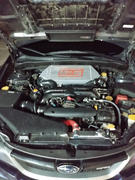Use Coupon Code BOOST5 at Checkout!
Use the chat function below to ask us anything you need!
GrimmSpeed Top Mount Intercooler Kit - 2008-2014 WRX
SKU: GRM 090010$999.00

Each intercooler uses two unique end tanks. The first accepts the hot charge air from the turbo and feeds it to the intercooler core. The second receives the cooled charge air from the core and delivers it to the throttle body. These end tanks are precision cast and machined in Minnesota. The bypass valve flange is milled flat and stainless steel studs are permanently installed to ensure that the aluminum threads don't become damaged and shorten the life of the intercooler. Following inspection, end tanks are welded to high density bar and plate intercoolers before the entire assembly is pressure tested, cleaned and sealed for shipment. 5-ply silicone couplers hold their shape in extreme conditions and ensure that charge air makes it to and from the intercooler with no trouble. Splitters are laser cut from aluminum sheet and CNC bent before being assembled and powdercoated with a durable texture black finish. Stainless steel hardware secures the splitter to the factory hood scoop.
GrimmSpeed setup testing to simulate a real world scenario that's typically demanding of an intercooler. The test vehicle is a 2012 WRX with a GrimmSpeed downpipe, boost control solenoid, prototype intake and professional tuning. On a closed course, they accelerated in 3rd gear from 3000rpm to redline repeatedly, with 5-8sec between runs. Temperature was logged via k-type thermocouples between the turbo and the intercooler and between the intercooler and the throttle body on both units. Ambient temperature in Minnesota for both tests was between 20 and 22 degrees F.
The results speak for themselves, but here's a breakdown. The phase differences between the runs are a result of how quickly we could safely get the car back down to speed for another run. Predictably, both intercoolers were seeing similar Pre-IC temperatures on each run (180-190F peak), but while the GrimmSpeed Uncoated TMIC kept Post-IC temperatures between 30-40F the entire time, the OEM TMIC fluctuated between 35-75F. This is the kind of consistent cooling that you should expect from a high quality TMIC and is a function of the geometry and design of the bar and plate core. Their high density core has a massive heat transfer surface area but maintains a large enough cross-sectional flow area that there's very little added restriction.
< Show Less
Share:
 i
i- Reviews
- Questions
Thank you for posting a question!
Your question will appear on the site once we've answered it.
Thank you for submitting a review!
Your input is very much appreciated. Share it with your friends so they can enjoy it too!
Grimspeed tmic
Very satisfied with the product , the packaging was extremely good!! Car feels a bit more responsive but it will help alot more once I get a protune , but overall stays cooler than the OEM one , still was a pain on the butt to put on specially the throttle side OMG that was hard , there is a very cool vid on YouTube for the install .
Customer Reviews
Related Items
Terms & Conditions
© 2025 New Provisions Racing. All rights reserved



































